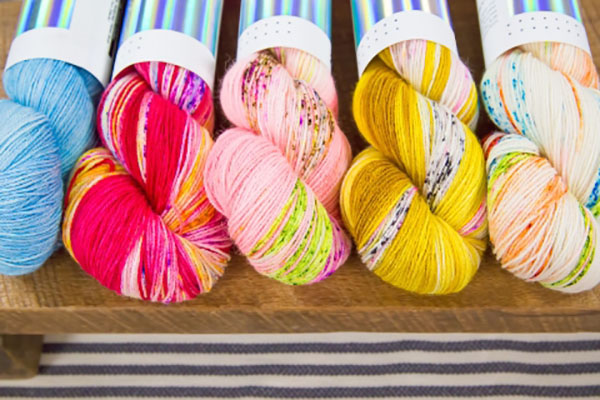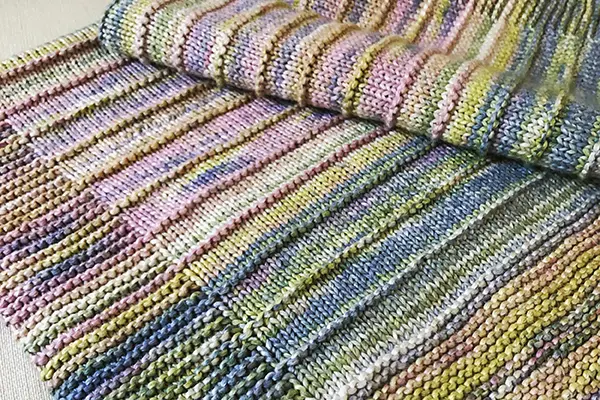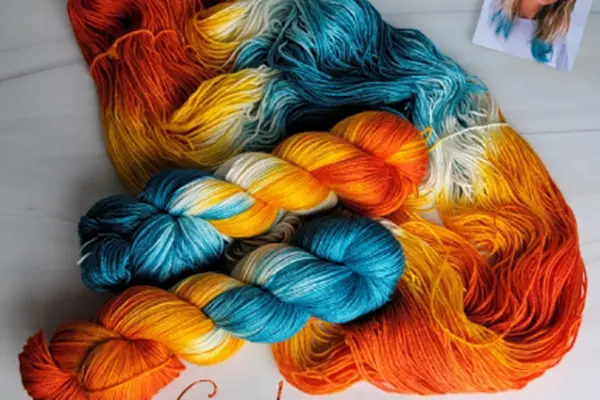Variegated yarn, with its beautiful, shifting colors, can turn a simple project into a work of art. But it can also be tricky. Have you ever started a project with a gorgeous skein, only to find the colors pooling in strange ways or clashing with your chosen pattern? As a manufacturer with decades of experience in the textile industry, I’ve seen it all. We’ve dedicated entire production lines to perfecting the art of dyed yarn, understanding how every decision, from the base fiber to the dyeing technique, impacts the final product.
This article is your comprehensive guide to mastering variegated yarn. We’ll go beyond the pretty colors and dive deep into the practical side of things. You’ll learn how to choose the right yarn for your project, which stitch patterns will make your colors sing, and how to tame common issues like pooling. Whether you’re a garment manufacturer looking to source reliable, high-quality yarn or a designer aiming to create stunning pieces, this guide will provide the expert insights you need to work with variegated yarn confidently and achieve beautiful, predictable results every time.
What Exactly is Variegated Yarn and How is it Made?
At its core, variegated yarn is a single strand of yarn that features multiple colors. Unlike a solid or semi-solid yarn which maintains a consistent hue, this type of yarn is intentionally dyed to produce a variety of shades. These can range from subtle tonal shifts within the same color family to a vibrant explosion of completely different colors. The magic lies in how these colors interact as you knit or crochet, creating unique fabrics that are impossible to achieve with a single color. You might hear different terms like self-striping, gradient, ombre, or speckled yarn, and these are all forms of variegated yarn, each defined by how the dye is applied and the length of each color section.
The creation of this colorful yarn is a fascinating blend of art and science. The process typically starts with a neutral base yarn, often a natural fiber like wool or cotton, or a durable synthetic like polyester. From there, the dye is applied in specific, controlled sections. For a self-striping yarn, the dye is applied in long, regular repeats, so as you work, the yarn will automatically create stripes of color. For a speckled yarn, a base color is applied, and then flecks of contrasting dye are sprinkled or painted on to create a confetti-like effect. The length of each color section in the skein is the key factor that determines how the yarn will behave in your finished project.
As a manufacturer, precision in this dyeing process is paramount. Each skein must have a consistent distribution of color to ensure that a large-scale project, like a garment, looks cohesive. The goal is to produce a yarn that is not just beautiful on the skein but translates predictably into a finished fabric. It’s a delicate balance that requires deep knowledge of both the dye and the fiber itself.

How Do Different Dye Techniques Affect the Final Yarn?
The technique used to dye the yarn has a massive impact on its final appearance and how it works up in a project. There are two primary methods: hand-dyeing, often done by indie dyers in small batches, and industrial machine dyeing, which is what we specialize in for larger, more consistent lots. Each has its own unique characteristics. A popular hand-dyed technique is kettle dyeing, where yarn is submerged in a pot with dye that is not fully mixed. This creates a beautiful, semi-solid or tonal yarn with subtle variations in shade and depth, giving the final fabric a rich, organic feel.
Another popular technique is speckling. This is where the dyer takes a skein of yarn, often already dyed a base color, and literally sprinkles, flicks, or paints on specks of concentrated dye. This creates a fun, modern look that can range from a light dusting of color to a bold, all-over speckle. The application of dye can be very random or carefully controlled, depending on the desired outcome. This technique is fantastic for adding a pop of interest without overwhelming a project.
On an industrial scale, we use sophisticated machinery to apply dye with incredible precision. This allows us to create long, consistent colorways for self-striping yarn or to replicate a specific variegated pattern across thousands of skeins. This consistency is crucial for our clients, who might be creating a line of sweaters and need every single garment to match. While it may lack the one-of-a-kind nature of a single hand-dyed skein, it provides reliability and predictability, ensuring that the yarn you swatch is the same yarn you’ll be using for your entire production run. The dye technique chosen ultimately defines the personality of the yarn.
What are the Biggest Challenges When Working with a Variegated Yarn Project?
While the potential reward of a beautiful, colorful project is high, working with variegated yarn does present some unique challenges. The most notorious of these is "pooling." This happens when the lengths of the color repeats in your yarn coincidentally line up with the width of your project, causing the colors to stack on top of each other and form unintended patches or "pools" of one color. While sometimes this can be a cool effect, it’s often distracting and can detract from the beauty of the overall piece.
Another challenge is that a very "busy" variegated yarn—one with many bright colors in short repeats—can obscure intricate stitch work. If you’ve chosen a complex lace or cable pattern, the constant color changes in the yarn can make the stitch definition difficult to see. The yarn and the pattern end up competing for attention, and the beautiful texture you worked so hard to create gets lost. This is a common pain point for designers who fall in love with a skein of yarn and a stitch pattern separately, only to find they don’t work well together.
Finally, there’s the issue of consistency between skeins. This is especially true for hand-dyed yarn, where no two skeins are ever truly identical, even when from the same dye lot. If you’re working on a larger project like a sweater or blanket, you might notice a distinct shift in color when you switch to a new skein. This can create an unwanted block or stripe in your work. Careful planning and specific techniques are needed to blend skeins together seamlessly, ensuring a professional and cohesive finished project. This is a problem that large-scale, quality-controlled manufacturing aims to solve.

How Can I Predict and Control Color Pooling in My Knit or Crochet Project?
Color pooling can be the bane of a knitter’s or crocheter’s existence, but the good news is that you are not powerless against it! The first and most important step is to make a swatch. I cannot overstate this. Knitting or crocheting a small square will show you exactly how the yarn’s color repeats will behave with your chosen stitch, needle size, and tension. If you see pooling you don’t like in the swatch, you can make adjustments before you’ve invested hours into your project.
If pooling occurs, you have several options. One of the most effective techniques is to alternate skeins. This is a must for any project using more than one skein of variegated yarn, especially if it’s hand-dyed. You simply work two rows from one skein, then two rows from a second skein, carrying the unused yarn up the side of your work. This mixes up the color distribution and breaks up any potential pools, blending the skeins together beautifully.
Another solution is to change the number of stitches in your rows. If you’re making a scarf, you could simply add or subtract a few stitches to alter the width. This changes how the color repeats line up and can often eliminate pooling entirely. For a project worked in the round, like a hat or sock, introducing a "jogless" stitch or a different stitch pattern for a round or two can also disrupt the color stacking. Sometimes, simply embracing the chaos is the best approach, but for those who want control, these techniques offer a reliable solution to manage how your colors interact.
Which Stitch Patterns Best Showcase Variegated Yarn?
When you have a yarn that is a star in its own right, you want to choose a stitch pattern that acts as a stage, not a competing actor. The goal is to let the colors shine. For this reason, simple stitch patterns are almost always the best choice for a highly variegated yarn. They provide a smooth, clean canvas that allows the color transitions to be the main focus.
Here are some of the best stitch patterns for variegated yarns:
| Stitch Pattern | Why It Works | Best For |
|---|---|---|
| Garter Stitch | The bumpy texture helps to break up colors and minimize pooling. It’s simple and lets the yarn do all the talking. | Scarves, blankets, simple shawls. |
| Stockinette Stitch | Creates a flat, smooth fabric that displays color changes clearly. Ideal for self-striping and gradient yarns. | Sweaters, hats, socks. |
| Moss Stitch | The simple alternation of knit and purl stitches creates a subtle texture that diffuses the colors beautifully, preventing harsh lines. | Cowls, hats, garment borders. |
| Linen Stitch | This stitch creates a woven-like fabric that breaks up the colors into tiny flecks. It’s a fantastic way to manage a yarn that might otherwise pool. | Scarves, placemats, bags. |
These stitch patterns often work because they don’t have a lot of their own texture or geometry to compete with the yarn color. They provide a backdrop that allows the dyer’s work to be fully appreciated. When you invest in a gorgeous skein of yarn, choosing one of these simple, elegant stitch options ensures that your finished project will look just as good, if not better, than the yarn did in the skein.
When Should You Avoid a Complex Pattern with Variegated Yarn?
Knowing when not to use a variegated yarn is just as important as knowing when to use it. The general rule of thumb is this: if the stitch pattern is complex, use a simple yarn. If the yarn is complex, use a simple stitch pattern. When you try to pair a busy yarn with a busy pattern, the result is often a chaotic mess where neither element can be properly appreciated.
You should strongly consider using a solid or tonal yarn instead of a variegated one for projects that feature intricate lace, complex cables, or detailed texture. The frequent color shifts of a variegated yarn will almost certainly obscure the delicate holes of a lace pattern or the twisting paths of a cable. Your hard work creating those beautiful stitches will be lost in the visual noise of the yarn. Imagine knitting a complex Aran sweater with a yarn that has five different colors—the cables would be nearly invisible.
This is a key consideration for garment manufacturers and designers. The choice of yarn must enhance, not detract from the beauty of, the design. If the design’s main feature is a unique stitch, a solid yarn will highlight it. If the main feature is the color story, then a variegated yarn with a simple stockinette or garter stitch is the perfect choice. It’s about creating balance. Before you start a project, lay the skein of yarn on top of the printed pattern. If it feels like too much is going on visually, it probably is. Trust your instincts and save that gorgeous variegated skein for a simpler project where it can truly be the star.

What’s the Best Way for Pairing Variegated Yarn with Solid Colors?
Pairing a vibrant variegated yarn with a solid color is a fantastic technique to create sophisticated, balanced projects. The solid color provides a place for the eye to rest, making the variegated section pop even more. This approach gives you the best of both worlds: the fun of a colorful yarn and the structure of a solid. There are several effective strategies for a successful pairing.
One of the most popular methods is to use the solid color for structural elements of a garment. Think of a sweater with a variegated body but solid-colored cuffs, hem, and collar. This frames the colorful section beautifully and gives the finished garment a polished, professional look. You can pull one of the subtle colors from the variegated skein for a harmonious match or choose a high-contrast neutral like grey, black, or cream to make the colors truly sing. This technique works equally well for a pair of socks with a solid heel and toe or a shawl with a solid border.
Another great strategy is color blocking. You can alternate sections of variegated yarn with sections of a solid color. This is perfect for a striped scarf or a modern blanket. This method helps to break up the busy-ness of the variegated yarn and can also help you stretch a special, expensive skein further. When choosing your solid, it’s a fun way to highlight one of your favorite colors from the variegated colorway. Hold the skein of yarn up to different solid yarns to see which one makes it come alive. This pairing is a powerful design tool to elevate a simple project into something truly special.
How Do I Choose the Right Variegated Yarn for a Project like a Shawl or Sweater?
Choosing the right variegated yarn is highly dependent on the scale of your project. The length of the color repeats in the yarn will interact differently with a small project, like a hat, versus a large one, like a sweater. Understanding this relationship is key to avoiding unintended and sometimes wacky results.
For large projects like a sweater, blanket, or expansive shawl, a yarn with long color repeats is often a better choice. Yarns with very short, frequent color changes can look chaotic and overly busy when spread across a large canvas. A gradient yarn, which transitions slowly from one color to the next, or a self-striping yarn with wide bands of color can create a more cohesive and intentional look. Before buying yarn for a large garment, it’s crucial to see a knitted swatch to understand how the colorway will behave over a larger surface area.
Conversely, for smaller projects like a hat, a pair of socks, or a cowl, you can have a lot more fun with short color repeats. A speckled yarn or a yarn with quick, flashy changes can be incredibly charming in a small accessory. A yarn that might pool strangely in a sweater can create fun, random flashes of color in a sock. The classic project for a wild, colorful skein of variegated yarn is, for good reason, a simple pair of stockinette socks. It’s the perfect canvas to let a crazy yarn do its thing without becoming overwhelming.
"As a manufacturer, we think about this constantly. We design different yarn colorways specifically for different projects. A yarn intended for a cozy sweater will have a different dye structure than a yarn we produce for a fun, colorful hat. The end-use is always part of the design process." – Allen, Jinyuent
Can You Use Variegated Yarn for Complex Colorwork Techniques?
This is a tricky question, and the answer is a qualified "yes, but be careful." Using a highly variegated yarn in traditional stranded colorwork techniques like Fair Isle can be a recipe for disaster. Colorwork relies on high contrast between two or more colorways to make the pattern visible. If you use a busy variegated yarn as either the main color or the contrast color, the pattern will likely become a muddy, illegible mess.
However, there are ways to incorporate this type of yarn into colorwork successfully. The best method is to use the variegated yarn as one of the colors and pair it with a very high-contrast solid color. For example, you could knit a cowl with a dark, solid navy blue and a vibrant, rainbow-speckled yarn. The solid color will provide the structure and allow the pattern to be seen, while the speckle underneath adds a little bit of depth and fun. The key is to ensure there is always a clear difference in value (lightness/darkness) between your chosen yarns.
Mosaic knitting is another technique where a variegated yarn can work beautifully. In mosaic knitting, you only work with one color per row, slipping stitches to create the pattern. This means the colors don’t get twisted together like in Fair Isle. Pairing a solid with a variegated yarn in a mosaic pattern can create stunning, intricate-looking fabric where the colors of the variegated yarn shift and shimmer within the pattern’s design. As always, the key is to swatch first to see how your two yarns will interact.
What Should I Look for in High-Quality Variegated Yarn from a Supplier?
For hobbyists and large-scale manufacturers alike, the quality of the base yarn is the foundation of a successful project. When you’re sourcing yarn, especially from a B2B supplier like us, there are several critical factors to consider that go beyond just the color. These are the things that ensure your final products are consistent, durable, and beautiful.
First, examine the consistency of the dye. Ask a potential supplier about their dyeing process. How do they ensure that Colorway A from Batch 1 is a near-perfect match to Colorway A from Batch 100? This is a major pain point for businesses. Inconsistent dye lots can ruin a production run. At Jinyuent, we use computerized dyeing and rigorous quality control to guarantee that our high-quality dyed yarn is consistent over time. You should also inquire about colorfastness. The most beautiful yarn in the world is useless if the dye bleeds in the first wash.
Second, consider the quality of the base fiber. The yarn should feel good and be appropriate for the end-use. Is the wool soft and not scratchy? Is the High fiber cone cotton thread strong and smooth? The yarn should be free of knots and slubs (unless it’s a stylistic choice), and the ply should be consistent. A reliable supplier should be transparent about their fiber sources and any certifications they hold, such as OEKO-TEX, which guarantees the yarn is free from harmful substances. We pride ourselves on sourcing only the best raw materials for all our products, from simple Yarn balls to industrial-grade threads. This commitment to quality is the cornerstone of a good supplier-client relationship.
Key Takeaways
Working with variegated yarn is a rewarding journey that can add incredible depth and personality to your projects. By keeping a few key principles in mind, you can navigate its challenges and unlock its full potential.
- Simple is Best: Pair busy, colorful yarn with simple stitch patterns like garter or stockinette to let the colors be the star.
- Swatch, Swatch, Swatch: Always knit or crochet a test square to see how your yarn will behave before starting a large project. This helps you predict and prevent unwanted pooling.
- Alternate Your Skeins: When using multiple skeins of variegated yarn for one project, work from two at once, alternating every couple of rows to blend them seamlessly.
- Pair with Solids: Use a solid color for cuffs, borders, or in color-blocked sections to frame the variegated yarn and create a balanced, professional look.
- Match Yarn to Project Size: Use yarns with long color repeats for large projects like sweaters and save the wild, speckled yarns for smaller accessories like hats and socks.
- Choose a Quality Supplier: For consistent color, high-quality fiber, and reliable results, partner with a manufacturer who prioritizes quality control and transparency in their dyeing process.





